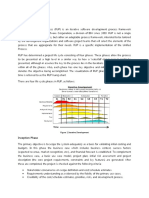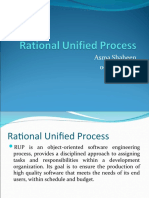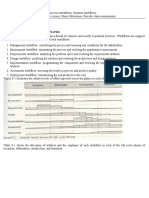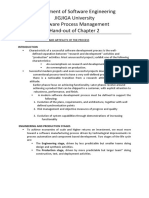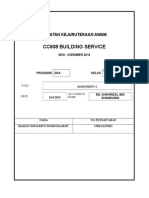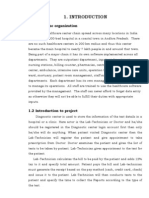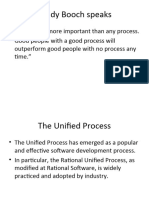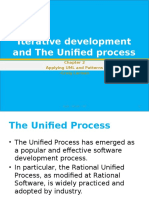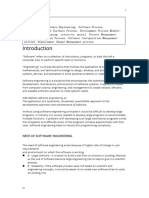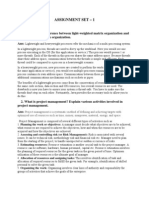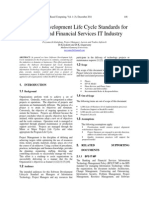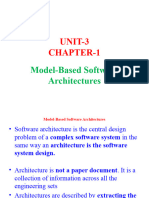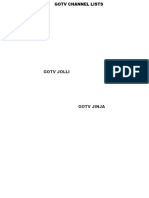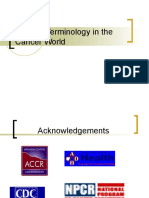0 ratings0% found this document useful (0 votes)
14 viewsSPM Unit 3
SPM Unit 3
Uploaded by
SF030 SravaniCopyright:
© All Rights Reserved
Available Formats
Download as PDF, TXT or read online from Scribd
SPM Unit 3
SPM Unit 3
Uploaded by
SF030 Sravani0 ratings0% found this document useful (0 votes)
14 views65 pagesOriginal Title
SPM-UNIT-3
Copyright
© © All Rights Reserved
Available Formats
PDF, TXT or read online from Scribd
Share this document
Did you find this document useful?
Is this content inappropriate?
Copyright:
© All Rights Reserved
Available Formats
Download as PDF, TXT or read online from Scribd
Download as pdf or txt
0 ratings0% found this document useful (0 votes)
14 views65 pagesSPM Unit 3
SPM Unit 3
Uploaded by
SF030 SravaniCopyright:
© All Rights Reserved
Available Formats
Download as PDF, TXT or read online from Scribd
Download as pdf or txt
You are on page 1of 65
UNIT 3
LIFE CYCLE PHASES
The most important Characteristic of a successful
software development process is the well-defined
separation between "research and development"
activities and "production" activities.
Suppose any software project is failed the primary
reason is improper seperation of these two stages.The
unsuccessful projects exhibits the following
characteristics.
1. An overemphasis on research and development
2. An overemphasis on production.
A modern software development process must be
defined to support the following:
1. Evolution of the plans, requirements, and
architecture, together with well-defined
synchronization points
2. Risk management and objective measures of
progress and quality
3. Evolution of system capabilities through
demonstrations of increasing functionality.
Engineering and Production Stages
The economic factor provides a simple framework for
deriving a lifecycle picture.
To achieve the scale of economics and higher returns
on investment, the developers should develop the
software with process automation and in component-
based development model. Two stages of the life-cycle:
1. The engineering stage – driven by less
predictable but smaller teams doing design and
synthesis activities.
2. The production stage – driven by more
predictable but larger teams doing construction,
test, and deployment activities.
The transition between engineering and production is
a crucial event for the various stakeholders.
Generally the production plans are agreed after
enough understanding of the problem and all the
stakeholders are agreed to the particular solution and
committed to go for production.
Engineering stage is decomposed into two distinct
phases, inception and elaboration, and the
production stage into construction and transition.
The following diagram shows the
development of project stages
Here the size of the spiral corresponds to the
sluggishness of the project with respect to the artifacts
that has been developed.
This sluggishness visualizes the maintaining the
process or development consistency, regression
testing ,documentation, quality analysis and
configuration control.
INCEPTION PHASE
The over all goal of the inception phase is to achieve
the concurrence between the stakeholders and life-
cycle phases of the project.
The following are the primary objectives and the
essential activities of the inception phase.
Primary objectives
1. Establish the project's software scope and boundary
conditions, including an operational concept,
acceptance criteria, and a clear understanding of what
is and is not intended to be in the project.
2. selecting the critical use cases of the system and the
primary states of operation that will reduce the major
design trade-offs.
3.Estimating the cost and schedule for the entire
project
4. Estimating potential risks
Essential Activities
1. Formulating the scope of the project. This activity
involves capturing the requirements and operational
concepts in an information repository that describes
user’s view the requirements The information
repository should be sufficient to define the problem
space and derive the acceptance criteria for the end
product.
2. Synthesizing the architecture. Here design
drawbacks, problem space ambuigities, and available
solution space ass are evaluated.
3. Planning and preparing a business case. Alternatives
for risk management, staffing, iteration
plans, and cost/schedule/profitability trade-offs are
evaluated.
Primary Evaluation Criteria
1. Do all stakeholders concur on the scope definition
and cost and schedule estimates?
2. Are requirements understood?
3. Are the cost and schedule estimates, priorities, risks,
and development processes believable?
4. Are actual resource expenditures versus planned
expenditures acceptable?
Elaboration phase
We know that elaboration phase is most difficult one
than remaining three phases.
At the end of the elaboration phase, the total project
engineering is considered to be completed and project
goes to production.
The elaboration phase must ensure that the
architecture, requirements and plans are stable
enough and risks are sufficiently mitigated, cost and
schedule for the completion of the development can
be predicted within acceptable range.
Primary objectives
1. Base lining the architecture as rapidly as practical
2. Base lining the vision
3. Base lining a high-reliability plan for the
construction phase
4. Demonstrating that the baseline architecture will
support the vision at a reasonable cost in a
reasonable time
Essential Activities
1.Elaborate the vision
2.Elaborating the process and infrastructure
3.Elaborating the architecture and selecting
components
Primary Evaluation criteria
1. Is the vision stable?
2. Is the architecture stable?
3. Does the executable demonstration show that the
major risk elements have been addressed and credibly
resolved?
Construction Phase
The construction phase represents a production
process, in which emphasis is placed on managing
resources and controlling operations to optimize
costs, schedules, and quality.
During the construction phase, all remaining
components and application features are integrated
into the application, and all features are thoroughly
tested.
Newly developed software is integrated where
required.
Primary objectives
1. Minimizing development costs by optimizing
resources and avoiding unnecessary scrap and rework
2. Achieving adequate quality as rapidly as practical
3. Achieving useful versions (alpha, beta, and other
test releases) as rapidly as practical
Essential Activities
1. Resource management, control, and process
optimization
2. Complete component development and testing
against evaluation criteria
3. Assessment of product releases against acceptance
criteria of the vision
Primary Evaluation Criteria
1. Is the project baseline mature enough to be deployed
in the user community?
2. Is this product baseline stable enough to be
deployed in the user community?
3. Are the stakeholders ready for transition to the user
community?
4. Are actual resource expenditures versus planned
expenditures acceptable?
Transition Phase
The transition phase is entered when project to be
deployed in the end user domain.
The transition phase requires a usable system has been
developed with acceptable quality levels and user
documentation.
This phase includes the following activities
1. Beta testing to validate the new system against user
expectations
2. Beta testing and parallel operation relative to a
legacy system it is replacing
3. Conversion of operational databases
4. Training of users and maintainers
Generally the transition phase focuses on the activities
to place the complete system in the hands of the user.
It includes, beta releases, bug fix and enhancement
releases. Here the developer puts his efforts for
developing user oriented documentation , training
users, supporting users for the product use.
Primary Objectives
1. Achieving user self-supportability
2. Achieving stakeholder concurrence that deployment
baselines are complete and consistent with the
evaluation criteria of the vision
3. Achieving final product baselines as rapidly and
cost-effectively as practical
Essential Activities
1. Synchronization and integration of concurrent
construction increments into consistent deployment
baselines
2. Deployment-specific engineering
3. Assessment of deployment baselines against the
complete vision and acceptance criteria in
the requirements set
Primary Evaluation criteria
1. Is the user satisfied?
2. Are actual resource expenditures versus planned
expenditures acceptable?
The Artifact Sets
To manage the complete software development
process, we should collect various kinds of information
and organized it in to artifact sets.
Each artifact set may have related artifacts that are
persistent and are in a uniform representation format.
Here set represents a complete view of the system and
an artifact represents unified information that is
developed as a single entity.
Generally the artifacts are divided in to five distinct
set in the project development life cycle.
Those are management set artifacts, requirement
artifact set, design artifact set, implementation artifact
set and deployment artifact set.
The Management Artifacts
The management artifact set consisting of the artifacts
related with process planning and execution. This set
use ad hoc notations such as text; graphics required to
represents the agreements among project personnel,
and among stake holders.
Management set artifacts are evaluated, assessed and
measured through the combination of the following.
1.Relevant stakeholder review
2.Analysis of changes between the current artifacts
with the previous artifacts.
3.Demonstrations need to balance all artifacts
The Engineering set Artifacts
The Engineering set artifacts consists of requirement
set, design set, implementation set and deployment
set.
The primary goal to evaluating quality of each artifact
set is transiting the information from one set to
another set.
So we can maintain balance among the requirements,
design, implementation, and deployment.
Requirement Artifacts
To specify the vision statement we use structured text
in requirement artifact, the vision document describe
the scope of the project.
Here we use some ad hoc formats for supplementary
specifications . Here we use UML notation for
engineering representation of requirements model.
The requirement set is primary to evaluate the
remaining three sets of artifacts
Requirement artifacts are evaluated , assessed and
measured through combination of the following
1)Analyze the consistency with the release
specifications of management set.
2)Analyze the consistency between the vision and the
requirements models.
3)Mapping the design , implementation and
deployment sets to evaluate the consistency and
completeness
4) The changes between current versions of
requirement artifacts with previous version.
5)Individual review of other dimensions of quality
Design Artifacts
UML notation is used to engineer the design models
for the solution.
The design set artifacts includes ,the design model,
test model, software architecture description.
The design set artifacts are evaluated, assessed, and
measured through a combination of the following:
Analyze the internal consistency and quality of the
design model
Analysis of consistency with the requirements models
Translate the design models into implementation and
deployment sets evaluate the consistency and
completeness between the sets
Analyze the change between the current version
design model and previous version design model
Individual review of other dimensions of quality
Implementation Artifacts
The implementation artifact set includes source code
that is useful to develop the working system
components and any executable required to test these
components.
Implementation set artifacts can be translated into
deployment set.
Implementation sets are in human-readable formats
that are evaluated, assessed, and measured through a
combination of the following:
Analyze the consistency with the design models
Translation into deployment set notations
Assessment of component source code or executable
files through inspection, analysis, demonstration, or
testing
Execution of stand-alone component test cases that
automatically compare expected results with actual
results
Analyze the difference between the current version of
artifacts with previous version.
Deployment Artifacts
The deployment set includes user deliverables and
machine language notations, executable software, and
the build scripts, installation scripts, and executable
target specific data necessary to use the project in user
environment.
Deployment sets are evaluated, assessed, and
measured through a combination of the following:
1)test the deployment set against the system usage
and the quality to be evaluated with respect to
consistency and completeness.
2)Test the usage scenarios –user manual, mainstream
usage, anomaly management.
3)Analyze the changes between the current version
and previous version .
4)Individual review of other dimensions of quality
The goal of artifacts is to optimize the process
activities and objectives.
There is no scientific methodology for selecting
management, requirement ,design, and
implementation
Generally each artifact set use different plans to gain
the relevant information of the system
The management artifacts concentrate on plans,
process, business objectives and acceptance criteria.
Reqirement artifacts concentrate on engineering
information and operational concepts.
Design artifacts concentrates on engineering
blueprints.
Implementation artifacts concentrate on building
block of the solution in the human readable form.
Deployment artifacts concentrate on solution in
machine readable form.
The modern software development process map to any
one of the artifact set.
1)Management : workflow, defect tracking , change
management , documentation , spread sheet ,resource
management and presentation tools
2)Requirements : requirements of management tools
Design: visual modeling tools
Implementation: compiler/debugger tools, code
analysis tools, test coverage analysis tools, and test
management tools
Deployment: test coverage and test automation tools,
network management tools, commercial components
and installation tools.
Implementation set versus
Deployment set
The implementation set and deployment set have their
own concept ,the differences between these two sets
are essential.
The structure of information delivered to the user is
entirely different from the structure of source code
executed in environment
We know that the engineering decisions has great
impact on quality and deployment of the system, at
the same time it is difficult to understand the
engineering decisions.
Artifact Evolution over the life cycle
Each state of development represents a certain amount
of precision in the final system description.
At the beginning of the life cycle, precision is low and
the representation is generally high.
Finally the precision is high and every thing is
specified in full detail.
Each phase of development focuses on a particular
artifact set. At the end of each phase, the system
development will process all the sets.
The following diagram represents the life cycle
evolution of artifact set
The inception phase focuses mainly on critical
requirements ,initial deployment view and little focus
on implementation primary focus on design
architecture.
During the elaboration phase, there is much greater
depth in requirements, much more breadth in the
design set, and further work on implementation and
deployment issues.
The main focus of the construction phase is design
and implementation.
The main focus of the transition phase is on
achieving consistency and completeness of the
deployment set in the context of the other sets.
Test Artifacts
In conventional software testing, document driven
techniques are used.
Generally the development teams built requirement
documents, top level design documents, and detailed
design documents in software development process.
In the same way before conducting the software
testing, the system test plan documents, system test
procedure documents, integration test plan
documents, unit test plan documents are constructed
by the testing team.
The testing is done basically by identifying the test
infrastructure. Due to this the following engineering
constraints are used in testing process.
The test artifacts must be developed concurrently with
the product from inception through deployment.
Thus, testing is a full-life-cycle activity.
The test artifacts are communicated, engineered, and
developed within the same artifact sets as the
development product.
The test artifacts are implemented in programmable
and repeatable formats .
The test artifacts are documented in the same way that
the product is documented.
Developers of the test artifacts use the same tools,
techniques, and training as the software engineers
developing the product.
The testing is only one aspect of the assessment of
workflow. Other Aspects include inspection, analysis
and demonstration.
The success of a test can be determined by comparing
the expected outcome to the actual outcome.
Management Artifacts
The management artifact set is used to capture
intermediate results and additional information
required to document the product/process.
This information have how to maintainable product,
how to improve the product and improvements of the
process.
Business case: The business case information is used
to determine whether investing in the project in
beneficial or not.
The business case artifact includes the expected cost,
revenue, backup data and technical management
plans.
The main purpose of business case is to transform the
vision into economics terms, so an organization can
make accurate ROI.
Software development Plan: The software
development plan(SDP) describes the process
framework in full detail.
Its a defined document of projects process.
Two important indicators of SDP are a) periodic
updating and b)understanding and acceptance by
managers
Work Breakdown Structure(WBS)
The work breakdown structure (WBS) is key featuring
for budgeting and collecting costs.
The project manager should have an idea about
projects costs.
Suppose the WBS may plan improperly it may cause
for project failure, because it has large impact on
design and production stages of the project.
The project manager concentrates on lower level of
WBS after particular level of stability achieved in the
project development
Software change order Database:
Managing change is one of the fundamental issues in
iterative development process. With good change
freedom, a project may develop more productively.
This change freedom can increases the flexibility in
project contents, quality, and number of iterations that
a project can achieve within a given schedule.
Generally Change freedom is achieved through process
automation
Release Specifications:
The projects plan scope and objective is assessed
before release.
This assessment criterion is depending on the projects
vision statement and many other parameters
Release description:
Release description documents describe the results of
each release, including performance against each of
the evaluation criteria in the corresponding release
specification.
You might also like
- Vocology OFFERDocument6 pagesVocology OFFERNicolásNo ratings yet
- Oracle Unified Methodology (Oum) : Project Execution and Control PhaseDocument5 pagesOracle Unified Methodology (Oum) : Project Execution and Control PhaseKeshav ChittipoluNo ratings yet
- 3-1binary Images Morphology ThresholdingDocument65 pages3-1binary Images Morphology ThresholdingGunay CaliskanNo ratings yet
- Traumatic Brain InjuryDocument15 pagesTraumatic Brain InjuryAbbey Janine Mandapat Passi100% (3)
- Prestonuniversity: Software Project ManagementDocument7 pagesPrestonuniversity: Software Project ManagementAbdul BakiNo ratings yet
- SPM Unit 2&3Document62 pagesSPM Unit 2&3subramanyam62No ratings yet
- SPM Unit 3Document17 pagesSPM Unit 3bhawanabaliwada2103No ratings yet
- 1.inception Phase: SPM Unit 2Document7 pages1.inception Phase: SPM Unit 2prudhvi chowdaryNo ratings yet
- Life Cycle Phases: Unit - IiiDocument20 pagesLife Cycle Phases: Unit - IiijarvisNo ratings yet
- Agile Project Management ApproachDocument9 pagesAgile Project Management ApproachpapimorokaNo ratings yet
- Figure 1 Iterative DevelopmentDocument3 pagesFigure 1 Iterative DevelopmentBayu RaharjoNo ratings yet
- Checkpoints of The Process: Unit - VDocument17 pagesCheckpoints of The Process: Unit - VvivekNo ratings yet
- Asma Shaheen 09-Ms-Se-07Document40 pagesAsma Shaheen 09-Ms-Se-07Sana AliNo ratings yet
- OOSE Full NotesDocument94 pagesOOSE Full NotesNepse KingNo ratings yet
- Sppm-Unit III Precise NotesDocument13 pagesSppm-Unit III Precise NotesWriter in the darkNo ratings yet
- SPPM Artifacts and PhasesDocument17 pagesSPPM Artifacts and Phases20WH1A0557 KASHETTY DEEKSHITHANo ratings yet
- The Unified Process in Software DevelopmentDocument4 pagesThe Unified Process in Software DevelopmentAmila Ruwan GurugeNo ratings yet
- Unit 2 NOtes SPMDocument10 pagesUnit 2 NOtes SPMAshish Singh RAJPUTNo ratings yet
- Unit 3 DocsDocument16 pagesUnit 3 DocsRaju Jacob RajNo ratings yet
- CS042 Unit I Introduction and Software PlanningDocument25 pagesCS042 Unit I Introduction and Software Planningpawanipec2010No ratings yet
- SPPM Unit 3Document19 pagesSPPM Unit 3divya reddy100% (1)
- Requirements Attributes Document GuidelinesDocument5 pagesRequirements Attributes Document GuidelinesJudy Lucy0% (1)
- Unit 6Document15 pagesUnit 6adik4420No ratings yet
- SPM Unit-5Document33 pagesSPM Unit-5vamsi kiranNo ratings yet
- IT301 - Assignment in Theoretical Understanding of SDLCDocument5 pagesIT301 - Assignment in Theoretical Understanding of SDLCroniversonrocas33No ratings yet
- Management of Time Uncertainty in AgileDocument12 pagesManagement of Time Uncertainty in AgileijseaNo ratings yet
- SOFTWARE ENGINEERING ANSWERS by PruthvirajDocument81 pagesSOFTWARE ENGINEERING ANSWERS by PruthvirajRanjit BichukaleNo ratings yet
- Department of Software Engineering JIGJIGA University Software Process Management Hand-Out of Chapter 2Document6 pagesDepartment of Software Engineering JIGJIGA University Software Process Management Hand-Out of Chapter 2Abdulaziz OumerNo ratings yet
- Unit 2Document19 pagesUnit 2mastersin2022No ratings yet
- COVER Building ServiceDocument12 pagesCOVER Building ServiceMaizan SofiaNo ratings yet
- Final Documentation For Print OutDocument69 pagesFinal Documentation For Print Outvivek.reddy537100% (6)
- FALLSEM2023-24 SWE2018 ETH VL2023240103236 2023-08-01 Reference-Material-IDocument27 pagesFALLSEM2023-24 SWE2018 ETH VL2023240103236 2023-08-01 Reference-Material-Irenukaashok2012No ratings yet
- Famina ME 2nd Sem Module 4Document20 pagesFamina ME 2nd Sem Module 4Abul KhayasNo ratings yet
- OOSE - Week 3 - Iterative Development - RUPDocument28 pagesOOSE - Week 3 - Iterative Development - RUPInnoxentDollNo ratings yet
- IA 1 QaDocument5 pagesIA 1 QaVINAYAKA.KNo ratings yet
- Unit 2. Software Process Primitives and Process Management FrameworksDocument83 pagesUnit 2. Software Process Primitives and Process Management FrameworksEfrain Sanjay AdhikaryNo ratings yet
- Software Engineering UNIT1Document16 pagesSoftware Engineering UNIT1TejasNo ratings yet
- Project Management MB0049Document14 pagesProject Management MB0049Abhishek JainNo ratings yet
- Paper1 SolutionDocument8 pagesPaper1 Solutionnishanth prNo ratings yet
- Unit 4 SDLCDocument5 pagesUnit 4 SDLChsisjsboNo ratings yet
- BC0054 - (Solved) Software Quality Management (2012)Document12 pagesBC0054 - (Solved) Software Quality Management (2012)Sohel AhmedNo ratings yet
- Life Cycle of The Project..2021Document40 pagesLife Cycle of The Project..2021Nayeem PashaNo ratings yet
- Evolutionary Development OverviewDocument21 pagesEvolutionary Development OverviewKarel HaanNo ratings yet
- Software FrameworkDocument5 pagesSoftware FrameworkufiiggovlNo ratings yet
- IT8075 Software Project Management NotesDocument132 pagesIT8075 Software Project Management NotesNAGARAJAN.N 011No ratings yet
- SPM MOD 1-5 - CompressedDocument132 pagesSPM MOD 1-5 - Compressed21951a1204No ratings yet
- What Is It?Document20 pagesWhat Is It?Kumar KrisshNo ratings yet
- Assignment-Software Engineering (21204012)Document7 pagesAssignment-Software Engineering (21204012)mislam.zidan05No ratings yet
- Project Control & Process Instrumentation: Chapter-1Document12 pagesProject Control & Process Instrumentation: Chapter-1NareshNo ratings yet
- Cs ProjectDocument41 pagesCs Projectavan joNo ratings yet
- SPM NotesDocument131 pagesSPM Notesjaya rajNo ratings yet
- Paper 47Document38 pagesPaper 47ayushymNo ratings yet
- Software EngineeringDocument17 pagesSoftware EngineeringNilesh KumarNo ratings yet
- Cpl230-Pengembangan Perangkat Lunak (Pertemuan-2) : 5165-Kundang K Juman, Ir, MMSIDocument57 pagesCpl230-Pengembangan Perangkat Lunak (Pertemuan-2) : 5165-Kundang K Juman, Ir, MMSIAhmad SyamsudinNo ratings yet
- SPM 1,2Document21 pagesSPM 1,2Harini HariNo ratings yet
- SPM Unit 1 NotesDocument35 pagesSPM Unit 1 Notesansh.2125cse1064No ratings yet
- Software Engineering and Project Management NotesDocument22 pagesSoftware Engineering and Project Management NotesPari BhandarkarNo ratings yet
- SPM ProjectDocument42 pagesSPM ProjectAlankar ApteNo ratings yet
- UNIT-III Chapter1,2,3 Full NotesDocument40 pagesUNIT-III Chapter1,2,3 Full NotesvijayalaxmibindlaNo ratings yet
- UP ProcessDocument7 pagesUP ProcessLastrat あMVNo ratings yet
- Essential Managed Healthcare Training for Technology Professionals (Volume 2 of 3) - Bridging The Gap Between Healthcare And Technology For Software Developers, Managers, BSA's, QA's & TA'sFrom EverandEssential Managed Healthcare Training for Technology Professionals (Volume 2 of 3) - Bridging The Gap Between Healthcare And Technology For Software Developers, Managers, BSA's, QA's & TA'sNo ratings yet
- Cost Estimation in Agile Software Development: Utilizing Functional Size Measurement MethodsFrom EverandCost Estimation in Agile Software Development: Utilizing Functional Size Measurement MethodsNo ratings yet
- Ruth B Edwards Kadmos The Phoenician A Study in Greek Legends and The Mycenaean AgeDocument280 pagesRuth B Edwards Kadmos The Phoenician A Study in Greek Legends and The Mycenaean AgeRoni Bou Saba100% (7)
- When God Is Glorified in Our LivesDocument4 pagesWhen God Is Glorified in Our LivesVintar First Baptist ChurchNo ratings yet
- AdjectivesDocument9 pagesAdjectivesGrace Ann HillNo ratings yet
- Suren Official Thesis Chapters 1-5Document66 pagesSuren Official Thesis Chapters 1-5eymi espinosaNo ratings yet
- Англиско -македонски речник со егејски дијалектDocument117 pagesАнглиско -македонски речник со егејски дијалектMareli DesignNo ratings yet
- Ddr3-Emac40-Queue-Manager Test Bench: - C2sisDocument20 pagesDdr3-Emac40-Queue-Manager Test Bench: - C2sisAnkit Goel100% (1)
- Ariba Invoice Exception Knowledge Base ArticleDocument2 pagesAriba Invoice Exception Knowledge Base ArticleCaitlin DoonanNo ratings yet
- NS-3 With Ndnsim Patch - TutorialDocument8 pagesNS-3 With Ndnsim Patch - TutorialAli NawazNo ratings yet
- E8 - HW Unit 5 - Test 1Document2 pagesE8 - HW Unit 5 - Test 1Minh ThiệnNo ratings yet
- PURCOM Activity 2Document2 pagesPURCOM Activity 2John AsentistaNo ratings yet
- Prontuario/Syllabus - Academic Year 2017-2018 - English 10Document4 pagesProntuario/Syllabus - Academic Year 2017-2018 - English 10W. MeyersNo ratings yet
- Converting Visual Basic 6 Source Code To B4ADocument15 pagesConverting Visual Basic 6 Source Code To B4AAndrés Zumarán VerasNo ratings yet
- GOTV MaxDocument1 pageGOTV MaxobilanaakinNo ratings yet
- SpeakingggggDocument10 pagesSpeakingggggClent TrocioNo ratings yet
- Medical TermDocument33 pagesMedical TermZahra PratiwiNo ratings yet
- 7.style of ReferencingDocument11 pages7.style of ReferencingGaurav AtreyaNo ratings yet
- 2021 2nd Quarter Summative Test With Table of SPECS and Answer KeyDocument27 pages2021 2nd Quarter Summative Test With Table of SPECS and Answer KeyAna Carla de CastroNo ratings yet
- جراحه هام جداDocument80 pagesجراحه هام جداAmir AttaNo ratings yet
- App 005 Research Forms 1 3 SampleDocument7 pagesApp 005 Research Forms 1 3 SamplejimskerteNo ratings yet
- Assignment 1Document3 pagesAssignment 1Abdul HaseebNo ratings yet
- Bhasha, Bahubhashita Evam Shiksha Ka MadhyamDocument25 pagesBhasha, Bahubhashita Evam Shiksha Ka MadhyamKirtiNo ratings yet
- Candido Macy T Socstud2c Lit2 Module5Document5 pagesCandido Macy T Socstud2c Lit2 Module5Macy Tejada CandidoNo ratings yet
- Polyspace R2021a Results ListDocument130 pagesPolyspace R2021a Results ListPro Hdr GesNo ratings yet
- Type ConversionDocument17 pagesType Conversionmanjeshsingh0245No ratings yet
- Cambridge International AS & A Level: Computer Science 9608/22Document8 pagesCambridge International AS & A Level: Computer Science 9608/22apex legendsNo ratings yet
- Symbol Description Chord Quality ExamplesDocument2 pagesSymbol Description Chord Quality Examples王浩No ratings yet
- Sense RelationsDocument10 pagesSense RelationssohaNo ratings yet










